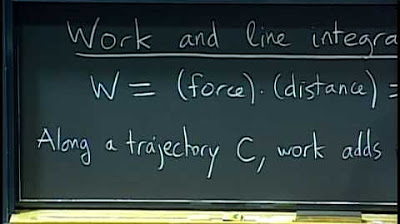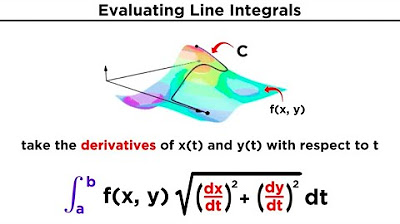Conservative Fields & Path Independence (Vector Fields)
TLDRThis Houston Math Prep video delves into the concept of gradient fields and their potential functions, illustrating how they can simplify line integrals. It explains that gradient fields, synonymous with conservative fields, are path-independent, meaning the work done by the field along a path is invariant to the path's shape. The video demonstrates how to find a potential function for a given vector field and use it to calculate work along a path or around a closed curve, highlighting the fundamental theorem of line integrals as a powerful tool for these calculations. It concludes with examples, including work along a segment of the unit circle, emphasizing the efficiency of these methods over traditional line integral computation.
Takeaways
- 📚 The video discusses the concept of a gradient field and its relation to potential functions, which can be used to simplify line integrals.
- 🔍 A gradient field is synonymous with a conservative field, indicating that the field represents a system where energy is conserved.
- 📈 The script explains that in a conservative field, the line integral is path-independent, meaning the work done is the same regardless of the path taken between two points.
- 🔑 The fundamental theorem of line integrals is introduced as a shortcut to calculate work in a gradient field without parameterizing the curve.
- 📝 To apply the shortcut, one must find the potential function associated with the gradient field and then simply subtract the function's values at the start and end points.
- 🔄 The video provides an example where the vector field \( F = (y, x) \) is shown to be a gradient field and its potential function is \( f(x, y) = xy \).
- 🔍 The script demonstrates how to calculate work along a path in a gradient field by plugging endpoints into the potential function, avoiding complex integral calculations.
- ⭕ When the curve is a simple closed curve in a gradient field, the work done is zero, which is a significant shortcut for calculating line integrals.
- 📐 The video gives an example of calculating work along a segment of the unit circle using the potential function, resulting in a simplified calculation.
- 🛑 If the vector field is not a gradient field, traditional methods of parameterizing the curve and calculating line integrals are necessary.
- 🌐 The script concludes with a mention of Green's theorem as a shortcut for closed curves, which will be covered in a subsequent video.
Q & A
What is the difference between a gradient field and a conservative field?
-There is no difference; a gradient field and a conservative field are synonymous. Both terms refer to a vector field that can be expressed as the gradient of some scalar function, indicating that the field has potential energy properties.
Why is a conservative field also called a gradient field?
-A conservative field is called a gradient field because it represents a system where energy is conserved, and mathematically, it can be expressed as the gradient of a scalar potential function.
What does it mean for a field to be simply connected?
-A simply connected region is one that does not have any holes or isolated points that cannot be encircled without leaving the region. It is a necessary condition for certain mathematical operations, including the application of the fundamental theorem of line integrals for conservative fields.
What is the fundamental theorem of line integrals and how does it simplify calculations in a gradient field?
-The fundamental theorem of line integrals allows for the simplification of line integrals in a gradient field by eliminating the need to parameterize the curve. Instead of integrating over the curve, one can simply evaluate the potential function at the endpoints and subtract.
How can you determine if a vector field is a gradient field?
-A vector field is a gradient field if the partial derivative of its component M with respect to y is equal to the partial derivative of its component N with respect to x, ensuring path independence.
What is the significance of a path-independent vector field?
-In a path-independent vector field, the work done or the line integral taken from one point to another is the same regardless of the path taken. This property is crucial for applying the fundamental theorem of line integrals and simplifying calculations.
Why is the work done in a conservative field along a closed curve always zero?
-In a conservative field, the work done along a closed curve is zero because the potential function, which is used to calculate the work, yields the same value at the starting and ending points of the curve, resulting in a net work of zero when subtracted.
Can you provide an example of a potential function for the vector field F = (y, x)?
-Yes, the potential function for the vector field F = (y, x) can be found by integrating each component with respect to its corresponding variable. The potential function is f(x, y) = xy + C, where C is a constant.
How does the fundamental theorem of line integrals apply to a line integral over a portion of the unit circle?
-For a line integral over a portion of the unit circle in a gradient field, the fundamental theorem of line integrals allows you to find the work done by plugging the endpoints of the curve into the potential function and subtracting the results, without needing to parameterize the curve or perform the integral directly.
What is the result of the line integral of F = (y, x) over a quarter of the unit circle from θ=0 to θ=π/4?
-The result of the line integral of F = (y, x) over this path is 1/2. This is found by evaluating the potential function at the endpoints (1,0) and (√2/2, √2/2) and taking the difference.
What is the next topic to be covered after the discussion of gradient fields and the fundamental theorem of line integrals?
-The next topic to be covered is Green's theorem, which provides a shortcut for calculating line integrals over closed curves when the vector field is not a gradient field.
Outlines
📚 Understanding Gradient Fields and Conservative Vector Fields
This paragraph introduces the concept of gradient fields and conservative vector fields, explaining that they are synonymous. It emphasizes the importance of understanding partial derivatives and the requirement for the field to be defined on a simply connected region. The paragraph clarifies that a conservative field represents a system where energy is conserved, allowing for the assignment of potential functions independent of the path taken between two points. The fundamental theorem of line integrals is introduced as a method to simplify calculations by eliminating the need to parameterize curves, instead using the potential function and its values at endpoints to find work done by the field.
🔍 Applying Path Independence in Gradient Fields
The second paragraph delves into the application of path independence in gradient fields, illustrating how to calculate work done by a vector field along a curve without the need for complex integrals. It provides an example using the vector field F = <y, x>, showing how to find the potential function and use it to calculate work from one point to another. The paragraph also discusses the implications of a closed curve in a gradient field, where the work done is always zero due to the nature of path independence, offering a shortcut for such cases. Two examples are given: one with a full unit circle resulting in zero work, and another with a quarter of the unit circle where the work is calculated using the potential function and the endpoints.
🛠 Efficient Methods for Calculating Line Integrals in Gradient Fields
The final paragraph outlines a general approach for efficiently calculating line integrals in gradient fields. It suggests a step-by-step process beginning with checking if the vector field is a gradient field and if the path is a simple closed curve, which simplifies the calculation to zero. For non-closed paths, the fundamental theorem of line integrals is used by finding the potential function and subtracting the function values at the start and end points. The paragraph concludes by noting that if the vector field is not a gradient field, traditional parameterization and line integral methods must be used, with a teaser for the next video on Green's theorem for closed curves.
Mindmap
Keywords
💡Gradient Field
💡Conservative Field
💡Path Independence
💡Potential Function
💡Line Integral
💡Fundamental Theorem of Line Integrals
💡Parameterization
💡Partial Derivatives
💡Simply Connected Region
💡Closed Curve
💡Green's Theorem
Highlights
Introduction to the concept of gradient fields and their application in simplifying line integrals.
Explanation of the equivalence between gradient fields and conservative fields.
Assumption of basic knowledge of partial derivatives and simply connected regions for using gradient field shortcuts.
Definition of a conservative field as a system where energy is conserved.
The potential function as a means to assign potential independently of the path taken.
Fundamental theorem of line integrals allows for shortcutting line integrals in gradient fields.
Demonstration of how to calculate work in a gradient field without parameterizing the curve.
Example of calculating work in the vector field F = (y, x) from (0,0) to (1,1) using the potential function.
Shortcut for calculating work in a gradient field with a closed curve, where the work is zero.
Explanation of the shortcut for simple closed curves in gradient fields, avoiding line integral computation.
Use of the potential function to calculate work along a segment of the unit circle in a gradient field.
Application of the fundamental theorem of line integrals to find the work along a non-closed curve.
General outline for efficiently finding the integral over a curve of F dot dR in gradient fields.
Process of checking if the vector field is a gradient field for potential shortcuts.
Approach for non-gradient fields, including parameterization and line integral computation.
Introduction to Green's theorem as a shortcut for closed curves, to be covered in the next video.
Conclusion and summary of the video's content on gradient fields and line integrals.
Transcripts
Browse More Related Video

Lec 20: Path independence and conservative fields | MIT 18.02 Multivariable Calculus, Fall 2007

Closed curve line integrals of conservative vector fields | Multivariable Calculus | Khan Academy

Line Integrals of Vector Fields (Introduction)

Lec 19: Vector fields and line integrals in the plane | MIT 18.02 Multivariable Calculus, Fall 2007

Conservative Vector Fields & Potential Functions

Evaluating Line Integrals
5.0 / 5 (0 votes)
Thanks for rating: